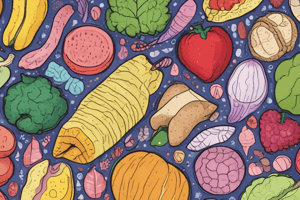Podcast
Questions and Answers
What effect do low glycemic index foods have on glucose absorption?
What effect do low glycemic index foods have on glucose absorption?
- They have no effect on glucose absorption.
- They completely prevent glucose absorption.
- They speed up the absorption of glucose.
- They slow down the rate of glucose absorption. (correct)
Which factor is NOT mentioned as influencing glycemic index?
Which factor is NOT mentioned as influencing glycemic index?
- Processing of food
- Fibre content
- Presence of fats and proteins
- Color of the food (correct)
What characterizes Type-1 Diabetes?
What characterizes Type-1 Diabetes?
- Increased insulin production.
- Develops exclusively during pregnancy.
- Insulin resistance in muscle tissue.
- Destruction of the pancreas due to autoimmune disease. (correct)
What is a potential risk of untreated gestational diabetes?
What is a potential risk of untreated gestational diabetes?
Which statement accurately describes Type-2 Diabetes?
Which statement accurately describes Type-2 Diabetes?
What is a key difference between 100% whole grain wheat bread and 100% whole wheat bread?
What is a key difference between 100% whole grain wheat bread and 100% whole wheat bread?
Which of the following is true about babies born to mothers with gestational diabetes?
Which of the following is true about babies born to mothers with gestational diabetes?
Which nutrient is most significantly lost when the germ is removed from bread?
Which nutrient is most significantly lost when the germ is removed from bread?
Which of the following describes the state of insulin resistance?
Which of the following describes the state of insulin resistance?
What does the Dietary Reference Intake (DRI) for dietary fibre indicate when the Adequate Intake (AI) is not met by 50% of a population?
What does the Dietary Reference Intake (DRI) for dietary fibre indicate when the Adequate Intake (AI) is not met by 50% of a population?
What is a common treatment for Type-1 Diabetes?
What is a common treatment for Type-1 Diabetes?
Which of the following statements about white bread is accurate?
Which of the following statements about white bread is accurate?
Why might adult Canadians have an inadequate fibre intake?
Why might adult Canadians have an inadequate fibre intake?
What is one of the functions of bran in whole grain bread?
What is one of the functions of bran in whole grain bread?
How is white flour made?
How is white flour made?
Which statement about fortified white bread is correct?
Which statement about fortified white bread is correct?
What happens to acetyl Co-A when carbohydrate intake is low?
What happens to acetyl Co-A when carbohydrate intake is low?
How does soluble fiber affect the glycemic response of food?
How does soluble fiber affect the glycemic response of food?
What characterizes a healthier glycemic response?
What characterizes a healthier glycemic response?
What is the glycemic index primarily used to measure?
What is the glycemic index primarily used to measure?
How is the glycemic index determined?
How is the glycemic index determined?
What occurs to insulin levels when blood glucose rises rapidly?
What occurs to insulin levels when blood glucose rises rapidly?
What is the reference food commonly used to evaluate the glycemic index?
What is the reference food commonly used to evaluate the glycemic index?
What is the average result for glycemic index obtained from?
What is the average result for glycemic index obtained from?
What happens to blood glucose levels in the early stages of insulin resistance?
What happens to blood glucose levels in the early stages of insulin resistance?
What is one major risk factor for the development of type-2 diabetes?
What is one major risk factor for the development of type-2 diabetes?
How does exercise benefit individuals with type-2 diabetes?
How does exercise benefit individuals with type-2 diabetes?
What is the potential outcome if insulin resistance and pancreatic function continue to worsen?
What is the potential outcome if insulin resistance and pancreatic function continue to worsen?
What dietary approach can help in the treatment or prevention of type-2 diabetes?
What dietary approach can help in the treatment or prevention of type-2 diabetes?
What effect does gluconeogenesis have in an insulin-resistant liver?
What effect does gluconeogenesis have in an insulin-resistant liver?
What indicates a shift towards pre-diabetes in blood glucose levels?
What indicates a shift towards pre-diabetes in blood glucose levels?
What can happen to the pancreas as insulin resistance develops?
What can happen to the pancreas as insulin resistance develops?
What is a common risk factor for cardiovascular disease mentioned in relation to carbohydrates?
What is a common risk factor for cardiovascular disease mentioned in relation to carbohydrates?
What initiates cancer according to the content?
What initiates cancer according to the content?
How does dietary fiber potentially reduce the risk of colon cancer?
How does dietary fiber potentially reduce the risk of colon cancer?
What is the process called when cancer cells spread to other parts of the body?
What is the process called when cancer cells spread to other parts of the body?
Which type of sweetener contributes little or no calories to food?
Which type of sweetener contributes little or no calories to food?
What is a significant safety issue associated with non-nutritive sweeteners?
What is a significant safety issue associated with non-nutritive sweeteners?
What role do short chain fatty acids play in colon health?
What role do short chain fatty acids play in colon health?
Which characteristic do both aspartame and sucralose share?
Which characteristic do both aspartame and sucralose share?
Flashcards are hidden until you start studying
Study Notes
Breads and Whole Grains
- 100% Whole Grain Bread contains endosperm, bran, and germ of the grain.
- 100% Whole Wheat Bread contains endosperm and bran, but the germ is removed.
- White Bread contains only the endosperm. Bran and germ are removed.
- White bread is fortified with iron, thiamin, niacin, and riboflavin, but this does not make up for all the nutrients lost when bran and germ are removed.
Dietary Fibre Intake
- Dietary Reference Intake (DRI) for dietary fibre is an Adequate Intake (AI).
- An AI is assigned when there is not enough research to determine an Estimated Average Requirement (EAR).
- If 50% or more of the population consumes above the AI, it’s deemed adequate.
- If less than 50% of the population consumes above the AI, it may or may not be adequate.
- Adult Canadians’ intake of fibre may or may not be adequate as less than 50% consume above the AI in all age categories.
Glycemic Response and Soluble Fibre
- Soluble fibre absorbs water and creates a viscous solution that slows the release of glucose from the gut and into the blood.
- This results in a more gradual rise and fall in blood glucose levels, which is healthier for the pancreas than a rapid increase followed by a sharp decline.
Glycemic Index (GI)
- Foods high in soluble fibre have a lower GI.
- GI is calculated by comparing the blood glucose response to a test food with the response to a reference food (50g glucose or white bread).
- Foods with a low GI slow the rate of glucose absorption, similar to soluble fibre.
- Factors influencing a low GI include fibre content, processing, and other components present, such as fat and protein.
Diabetes
- Diabetes is a disease characterized by high blood glucose levels, and is linked to the body's inability to produce or respond properly to insulin.
- Type 1 Diabetes: Body cannot produce insulin due to an autoimmune attack on the pancreas. Treated with insulin injections. Accounts for 10% of diabetic cases.
- Gestational Diabetes: Develops during pregnancy. Untreated, this can result in a large baby, causing complications during delivery. Babies born to mothers with gestational diabetes have an increased risk of obesity and type 2 diabetes later in life. Mothers with gestational diabetes also have an increased risk of developing type 2 diabetes later in life. Can be treated to decrease risk to both mother and infant.
- Type 2 Diabetes: Most common type, accounting for 90% of cases.
Type 2 Diabetes
- Type 2 diabetes is characterized by insulin resistance in muscle, liver, and adipose tissue, and reduced insulin secretion from the pancreas.
- Insulin Resistance: Muscle and adipose tissue do not respond to insulin's signal to take up glucose. As a result, glucose remains in the blood, causing damage to blood vessels, leading to increased heart disease risk.
- Liver: Insulin resistance prevents the suppression of gluconeogenesis, adding to high blood glucose levels.
- Initially, the pancreas compensates for insulin resistance by increasing insulin production. However, eventually, the pancreas becomes exhausted, resulting in insufficient insulin production to maintain normal blood glucose levels.
Risk Factors for Type 2 Diabetes
- Obesity is a major risk factor for type 2 diabetes.
- Type 2 diabetes typically develops during adulthood, but is increasingly being seen in children, teens, and young adults due to the rise in childhood obesity.
Treatment of Type 2 Diabetes
- Treatment includes:
- Weight loss: Obesity is a major risk factor.
- Exercise: Exercise promotes glucose uptake by muscle tissue, independently of insulin.
- Diet: Well-balanced dietary patterns are effective.
- Medication: Medication in combination with the above steps can be effective.
Dietary Patterns for Type 2 Diabetes Prevention and Treatment
- Several dietary patterns are linked to reduced risk for type 2 diabetes.
Carbohydrates and Cardiovascular Disease
- Foods high in free sugars may raise serum triglycerides, a risk factor for cardiovascular disease.
- Blood lipids will be discussed in more detail in Chapter 5.
Carbohydrates and Cancer
- Cancer is caused by mutations in a cell's DNA that lead to uncontrolled growth.
- These mutations can lead to the formation of a tumor, and cells from that tumor can spread to other parts of the body (metastasis).
- Carcinogens can initiate mutations (tumor initiators) or promote the growth of established tumors (tumor promoters).
- Dietary carcinogens can contribute to cancer development.
Colon Cancer and Dietary Fibre
- Studies show that dietary fibre can reduce the risk of colon cancer.
- Possible Mechanisms of Action:
- Fibre reduces the time fecal contents remain in contact with intestinal cells, potentially reducing exposure to carcinogens.
- Fibre undergoes fermentation by gut bacteria, producing short-chain fatty acids, which provide energy for colon cells and maintain their function.
- High-fibre foods also contain beneficial compounds like antioxidants and phytochemicals, which may help reduce cancer risk.
- Possible Mechanisms of Action:
Non-Nutritive Sweeteners
- These are sweeteners that contribute little to no calories.
- The safety of some non-nutritive sweeteners is controversial.
- Aspartame and Sucralose will be compared and contrasted.
Studying That Suits You
Use AI to generate personalized quizzes and flashcards to suit your learning preferences.




